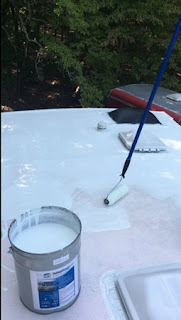The Ultimate Guide to RV Roof Sealant: Protecting Your Home on Wheels
Is it safe to say that you are a glad proprietor of a sporting vehicle (RV)? Provided that this is true, you comprehend the significance of keeping up with each part of your trailer, particularly its roof. One crucial element in RV maintenance is the roof sealant, a vital component that safeguards your investment from the elements and potential water damage. In this comprehensive guide, we'll delve into the world of RV roof sealants, discussing everything from types to application methods, ensuring your RV remains your trusted companion on the road for years to come.
Understanding RV Roof Sealant
Before we plunge into the quick and dirty subtleties of RV roof sealants, we should explain what they are and why they are fundamental. A RV roof sealant is a defensive covering applied to the roof of your camper to forestall water interruption, breaks, and harm. Without a legitimate sealant, your RV's roof could be defenseless against spills, which can prompt exorbitant fixes and compromise the solace of your movements.
Types of RV Roof Sealants
RV enthusiasts have several options when it comes to choosing the right sealant for their mobile homes. Here are the primary types:
RV Roof Sealer: This is a versatile and commonly used option. It's available in various forms, including liquid and tape, and is suitable for different roof materials.
RV Rubber Roof Sealant: Ideal for RVs with rubber roofs, this sealant provides a strong, flexible barrier against moisture and UV rays.
Camper Roof Sealant: Designed specifically for camper roofs, this sealant is durable and weather-resistant ensuring your home on wheels stays protected.
Applying RV Roof Sealant
Now that you're familiar with the types of RV roof sealants, let's discuss the application process. Follow these steps for a successful seal:
Preparation: Start by cleaning the roof thoroughly. Remove any dirt, debris, or old sealant. Ensure the surface is dry before proceeding.
Choosing the Sealant: Select the sealant that matches your RV's roof material. Really look at the producer's proposals for similarity.
Application: Utilize a reasonable utensil, like a brush or roller, to uniformly apply the sealant. Adhere to the maker's guidelines with respect to thickness and drying time.
Numerous Coats: Contingent upon the kind of sealant, you might have to apply various coats for greatest security. Be patient and allow each coat to dry properly.
Regular Maintenance: After the initial application, schedule regular inspections and maintenance to ensure your roof sealant remains in top condition.
Optimizing Your RV Roof Sealant
To optimize the performance of your RV roof sealant and enhance its longevity, consider the following tips:
Inspect Regularly: Keep an eye on your RV's roof for any signs of damage or wear. Catching issues early can prevent costly repairs.
Clean and Maintain: Periodically clean your roof to remove dirt, algae, and debris. This simple maintenance task can extend the life of your sealant.
Reapply as Needed: Over time, sealants can deteriorate. When you notice any cracks or areas with diminished protection, it's time to reapply the sealant.
Conclusion
Your RV roof sealant is a critical component of your mobile home's protection. Picking the right sort, applying it accurately, and keeping up with it routinely will guarantee your RV stays a dependable and agreeable friend on your excursions. In this way, whether you're looking for a RV roof sealer, RV rubber roof sealant, or camper roof sealant, recall that putting resources into quality sealant is an interest in the life span of your darling home on wheels.




Comments
Post a Comment